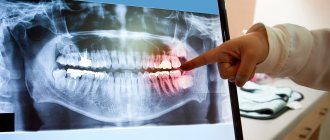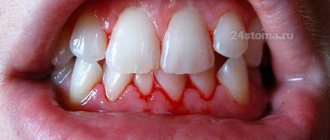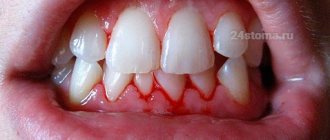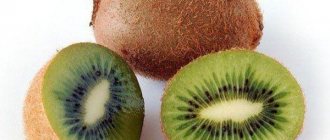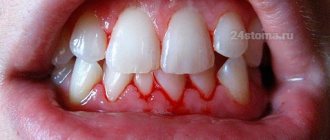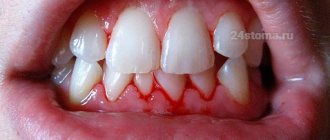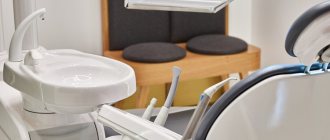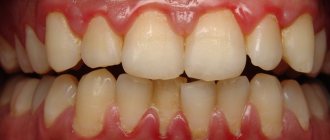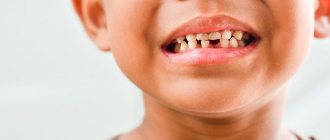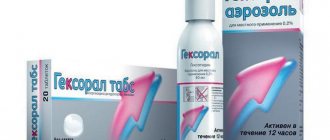If, when brushing your teeth or examining the oral cavity, you notice redness or swelling of your child's gums, this may indicate the development of gingivitis. If your child is already brushing his teeth himself, pay attention to his complaints of bleeding - this can also be a sign of gum inflammation. We’ll talk below about the symptoms of gingivitis, its treatment, and what to do if you suspect this disease in children.
Symptoms of gingivitis in children
Gingivitis is an inflammation of the gum mucosa. The proliferation of bacteria on its surface contributes to inflammatory processes and, as a result, unpleasant sensations and pain in the mouth.
The most common symptoms of gingivitis in children:
- swelling and redness of the gum mucosa (especially at the border with the teeth);
- the appearance of ulcers on the surface of the gums (fistula);
- increase in the amount of dental plaque;
- bleeding gums when brushing teeth and other mechanical influences.
Children usually also complain of pain, and in cases where gingivitis is diagnosed in children under 1 year of age, they simply become capricious and whiny. If you have any complaints of pain, you should first examine your child's mouth.
In very young children, gingivitis can accompany the eruption of new teeth. Therefore, be especially attentive to your child’s health and conduct regular oral examinations. Don't forget about your baby's hygiene at this age. Treat your gums with special dental wipes, for example, ASEPTA® Baby, which will help prevent gum inflammation.
These napkins are designed for oral hygiene of children from 0 to 3 years old. For older children, they are indispensable on the road, and can also be used to brush their teeth after eating outside the home. This is an excellent solution for maintaining child oral hygiene at any age.
Causes of inflammation and swollen gums during teething
The main prerequisites for the development of pericoronitis are:
- Mechanical injuries to the gingival tissue over the tooth germs due to hard foods, too hard toothbrushes, as well as due to other damaging factors.
- Long-term or difficult teething.
- Favorable conditions in the mouth for the accumulation of bacterial plaque and food particles under the gingival margin (insufficient hygiene, peculiarities of microflora in the oral cavity).
Swollen gums during teething are easily susceptible to traumatic influences, which leads to the development of inflammation. In this case, teething itself can be difficult for the following objective reasons:
- Dense bone tissue in the “eight” zone; bone compaction is most often formed because there are no milk teeth in this zone.
- There is not enough space for the “eight” in the dentition.
- Thickening of the gums and periosteum in the posterior part of the jaw is usually explained by the characteristics of embryogenesis.
Even one of these factors can cause the disease.
Causes of childhood gingivitis
This disease is quite common in children, including preschoolers and children of primary school age. Dentists call the main causes of gingivitis:
- accumulation of plaque on teeth (bacteria multiplication is observed when plaque is 1-5 days old);
- inadequate load on teeth and gums - reduced or, on the contrary, increased. This is typical for malocclusion pathology, uneven tooth growth, and crowding;
- mechanical trauma to the gum mucosa, including improper brushing of teeth, use of a brush with hard bristles, inept handling of dental floss;
- a general decrease in the child’s immunity due to acute respiratory viral infections, influenza, hypovitaminosis, and stress.
Gingivitis often occurs in combination with stomatitis, which increases pain and complicates the treatment of the disease.
Medicines for gingivitis
The medications your child needs are prescribed only by a doctor, based on the clinical picture of the disease and the individual condition of your child. Self-medication in this case is unacceptable, as it can lead to significant complications, including osteoporosis of bone tissue.
What to smear
Gels and ointments are applied after rinsing the mouth. The surfaces are pre-dried with a cotton swab or gauze.
Holisal.
The gel has a good anti-inflammatory and analgesic effect. Apply three times a day to the affected areas of the gums.
Apident active.
An ointment based on natural ingredients that quickly relieves pain and inflammation. The composition is applied to the inflamed areas and rubbed in with gentle circular movements.
Solcoseryl.
Used to heal bleeding areas, the gel is applied to both sides of the gums. Use as prescribed by a doctor.
Asepta gel.
Mainly prescribed for the treatment of chronic gingivitis. The drug relieves inflammation, pain, and itching well. Apply 2-3 times a day depending on the severity of the condition.
How to rinse
Important. Alcohol tinctures should not be used for rinsing, as their use will lead to even greater irritation.
Rinsing is mandatory when carrying out anti-inflammatory therapy. Carry out after each meal and additionally throughout the day. For young children, parents apply applications using cotton swabs soaked in solutions. In severe cases, treatment of the oral cavity and gums is carried out in the dental office.
For rinsing the following is prescribed:
- Chlorhexidine 0.05%.
Use after every meal. Rinse your mouth vigorously for 30 seconds. - Furacilin.
Use a ready-made 0.02% rinse aid or dissolve one tablet in a glass of boiled water. The drug disinfects the oral cavity well. - Furamistin 0.01%.
It has a powerful antibacterial effect and is used after meals. - Herbal infusions.
Prepare at home in accordance with doctor's recommendations.
Important. Before using solutions, rinse your mouth with clean water to remove any remaining food.
Antibiotics
In the chronic stage and in severe forms of the disease (ulcerative, ulcerative-necrotic), as well as in cases of high risk of complications, antibiotics are prescribed. The doctor selects the drug and dosage individually.
Types of gingivitis in children
Experts identify several types of this disease, depending on which symptoms may vary, and treatment methods may also vary. Pediatric gingivitis is divided into:
- Catarrhal.
- Ulcerative.
- Ulcerative-necrotizing gingivitis.
- Atrophic.
Let's look at them in more detail.
Catarrhal gingivitis is the most widespread, most often found in young children - up to 1 year. Signals of this form of the disease: bad breath, complaints of pain, bleeding gums, bad mood of the child. The baby may put his hands in his mouth as if something is bothering him, may whine, or refuse the breast or bottle. Gingivitis often manifests itself in children in an acute form - with fever, lethargy, complaints of pain and unpleasant sensations in the mouth.
The cause of catarrhal gingivitis in a one-year-old child is most likely to be poor oral hygiene and the entry of dirty objects into it, which can lead to the growth of bacteria on the mucous membrane. Untimely brushing of teeth or skipping this procedure, accumulation of food in a child’s mouth at night - all this is a direct path to gum inflammation.
Ulcerative gingivitis is characterized by the transition of redness and swelling of the gums to cyanosis with increased bleeding. The child will complain of pain and may refuse food. Most often, the ulcerative form appears as a consequence of catarrhal gingivitis that is not cured in time. An additional stimulus for the transition of the disease to this form will be a decrease in immunity against the background of an infectious or inflammatory disease, or hypothermia of the baby.
Ulcerative-necrotic is the most severe form of the disease; it is accompanied by a deterioration in the general condition of the body. Experts note that with such gingivitis in children, fever, the appearance of ulcers on the surface of the gums, green or gray plaque, increased viscosity of saliva, and a sharp putrid odor from the mouth. This type of disease occurs when ulcerative gingivitis is inadequately treated or the disease is ignored in the baby.
Atrophic gingivitis appears after errors in the treatment of teeth and oral cavity. In this case, the severity of the inflammatory process is not so high, the child may not even feel pain. It is usually detected during a routine examination by a dentist.
If gingivitis is detected in a child 2 years of age or older, who regularly attends a children's group, then it makes sense to check all children in the group for the presence of the disease. Since infection can occur through shared toys. In this case, we are talking about viral gingivitis in children.
Why do my baby's gums bleed?
Not only adults, but also children face the problem of bleeding and inflammation of the gums. In general, the reasons for this unpleasant phenomenon are approximately the same. Stomatitis, gingivitis, periodontitis, general functional disorders, mechanical damage, vitamin deficiency, infections and uncomfortable braces can bother both adults and young patients. The only case when blood in a child’s mouth is normal is during the period when milk teeth are replaced by molars. A loose tooth naturally injures the gums. In any case, if you have any doubts, take your child to see a specialist.
Gingivitis: treatment and prevention in children
Gingivitis, like any other disease of the teeth and gums, is easier to prevent than to cure. The surest way to prevent it is regular and proper oral care. It is in the mouth that pathogenic bacteria multiply, causing inflammation of the mucous membrane.
Tips for maintaining oral hygiene in children:
- Monitor how your child brushes their teeth. For children under two years old, it is better to carry out this procedure yourself. Remember that the movements of the toothbrush should be “sweeping” - from the base of the gums to the top of the tooth.
- Feed your child healthy, balanced foods. A sufficient amount of protein, fiber and minerals in your baby’s diet will protect him from gum disease. Limit your consumption of sweets and starchy foods.
- If your child has an abnormal bite or abnormal growth of teeth, including crowded or missing teeth, be sure to consult a specialist. Insufficient load or, conversely, overload of teeth and gums can cause gingivitis.
- Use soft toothbrushes with even bristles. Change them regularly - dentists recommend buying a new toothbrush once every three months.
- Be sure to choose toothpaste according to the child’s age.
Don't skimp on teeth and gum care products. After all, treatment will cost much more. An excellent choice is the ASEPTA children's toothpastes; they are available in three versions:
- for children from 0 to 3 years;
- from 4 to 8 years;
- for children over 8 years old.
The composition of each of these pastes fully meets the needs of children's teeth in each age period. They contain calcium in the form of lactate - this is the most easily absorbed form. Children's enamel will not lack this mineral. And the xylitol contained in the paste, a “tooth-friendly” sugar, gives it a sweet, pleasant taste. Unlike adult products, the ASEPTA BABY series does not contain excessive amounts of fluoride and menthol additives.
How to treat gingivitis in children
If you cannot avoid the disease, you must urgently seek help from a dentist. In any case, if you find redness of the gums, swelling or soreness of the mucous membrane, you should consult a specialist. Only a doctor can prescribe treatment. In addition, it is best to begin the fight against this disease by removing plaque and tartar, but this is impossible to do at home.
If you find that your child has red, swollen gums, or if the baby complains of pain in the mouth, be sure to visit the dentist in the coming days. Only a specialist will make an accurate diagnosis and prescribe the right treatment. Don't delay going to the doctor - the situation may get worse!
It is impossible to get rid of gingivitis at home, since gum inflammation can be caused by several reasons, including dental caries, tartar, and others. Before going to the dentist, prepare your child mentally:
- tell us how the dental examination will go;
- do not scare the baby, do not say that it will “not hurt” or “not be scary” - the child may begin to be afraid only because of your words;
- Watch cartoons with your child about going to the dentist.
Pay close attention to creating a menu for your baby during illness. Try to completely eliminate hot and cold foods and drinks, replacing them with warm ones, and also increase the amount of microelements and vitamins (especially groups A, B, C, D) supplied with food, or introduce them additionally into the diet.
If gingivitis is caused by constant mechanical injuries to the mucous membrane, change the child’s toothbrush and stop him from chewing pencils and other objects.
Also teach him how to brush his teeth properly. To do this, you can watch special training videos, which show in a playful way what movements need to be made when cleaning. Regular dental hygiene is the basis for the prevention of any oral diseases.
Gingivitis in children due to weakened immunity is treated etiologically - that is, the main efforts should be aimed at eliminating the cause of the underlying disease. So, if a child often suffers from ARVI or influenza, his diet should be balanced, vitamins, minerals, and lactic acid products should be included. Perhaps you should take more walks in the fresh air.
If your child is experiencing chronic stress, reconsider his daily routine. Perhaps you should give up some clubs or developmental activities, stop going to kindergarten for a while, spend more time with your baby, and reduce the demands on him from teachers or educators. All these measures can help reduce stress and boost the child’s immunity, which, in turn, will prevent gum disease.
Cyst treatment
A dental cyst is treated either with therapeutic methods or with surgical intervention. The first ones are used in simple cases.
Surgery involves two types of operations - cystotomy and cystectomy. In both cases, local anesthesia is used. With cystomy, only the anterior wall of the cyst is removed. This is a less traumatic option, as it allows you to preserve the rudiments of permanent teeth during surgery on milk teeth.
Cystectomy is performed if the size of the cyst does not exceed 1.5 cm. This operation is more difficult, but postoperative recovery is much faster.
No matter how small and insignificant the swelling may seem to you, contact your dentist. This will avoid complications. And the problem will be resolved more easily and in a short time. Remember that no rinses, infusions or other folk remedies can guarantee recovery.
What to do if you suspect gingivitis?
If, during examination of the oral cavity, you find redness and swelling of the gums, you should:
- make an appointment for your child with the dentist in the near future;
- if the baby has a fever, give him an antipyretic drug in accordance with his age;
- if you complain of pain, treat the gums with a 0.25% solution of potassium permanganate, a 3% solution of hydrogen peroxide in the form of irrigation or rinsing. These are temporary measures, they are not a treatment for gingivitis, but will simply relieve swelling and pain a little;
- take your child to the dentist.
Remember that oral hygiene and a healthy lifestyle are the key to strong teeth and healthy gums for your child!
Diagnostics
Treatment of absolutely any disease begins with diagnosis. Anzhelika Guryeva especially emphasizes that in dentistry, as in other areas of medicine, a differentiated approach to the problem is more important than ever: “A comprehensive examination will help to understand what exactly was the “trigger” - poor hygiene or pathological disruptions in the body.”
To make a correct diagnosis and prescribe adequate treatment, it is necessary to carry out a whole range of diagnostic measures:
— the doctor collects anamnesis during a personal conversation with the patient regarding symptoms that bother him;
- after this, the specialist examines the oral cavity to determine the depth of the periodontal pockets and the amount of deposits accumulated in them and to understand how far the process has gone;
— computed tomography allows you to accurately assess the degree of periodontal damage, if any;
— if necessary, the patient will be asked to additionally donate blood for sugar, hormones and lack of vitamins and microelements.
pixabay.com/Semevent
